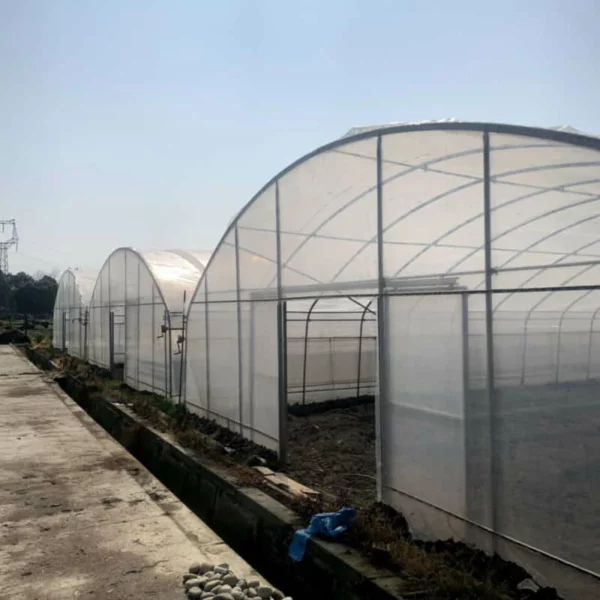What is the difference between a single-span greenhouse and a multi-span greenhouse
The difference between a single-span greenhouse and a multi-span greenhouse lies in their structural design and the number of spans they have. Here’s a breakdown of the distinctions:
Single-Span Greenhouse:
- Structure: A single-span greenhouse consists of a single continuous structure with a clear span or width. It typically has a peaked or curved roof design and is supported by columns or trusses at the ends.
- Size: Single-span greenhouses are generally smaller in size compared to multi-span greenhouses. They are often used for smaller-scale operations or for specific purposes such as research, propagation, or starting plants.
- Function: Single-span greenhouses are suitable for a variety of applications, including plant production, seedlings, or specialized crop production. They can be used for both seasonal and year-round cultivation.
- Flexibility: Single-span greenhouses offer flexibility in terms of layout and crop rotation. They can be easily adapted to different crop requirements and production schedules.
- Construction: Building a single-span greenhouse typically requires less material and construction time compared to larger multi-span structures. This makes them more cost-effective and easier to construct or expand.
- Control Systems: Single-span greenhouses can be equipped with environmental control systems such as heating, ventilation, and irrigation. However, the control systems may be simpler compared to those in larger multi-span greenhouses.
Multi-Span Greenhouse:
- Structure: A multi-span greenhouse consists of multiple spans or sections connected together. Each span has its own roof and support structure, creating a larger overall greenhouse structure.
- Size: Multi-span greenhouses are generally larger in size compared to single-span greenhouses. They are often used for commercial-scale operations or larger crop production.
- Function: Multi-span greenhouses are suitable for various crops, including flowers, vegetables, and fruits. They provide ample space for plant growth and can accommodate multiple growing techniques such as raised beds or hydroponics.
- Efficiency: Multi-span greenhouses are designed for efficient use of space and resources. The individual spans can be divided into different growing zones or compartments, allowing for crop specialization, staggered planting, or varied environmental conditions.
- Environmental Control: Multi-span greenhouses often have sophisticated environmental control systems that regulate temperature, humidity, ventilation, and irrigation. These systems are designed to optimize growing conditions and ensure consistent crop production.
- Commercial Operations: Multi-span greenhouses are commonly used for commercial-scale agricultural production. They are well-suited for large-scale crop cultivation, continuous production, and year-round operation.
- Economic Considerations: Due to their larger size and more advanced technology, multi-span greenhouses generally require a larger investment compared to single-span greenhouses. However, they offer the potential for higher yields and increased profitability in commercial farming operations.
In summary, the main differences between single-span and multi-span greenhouses are their size, structural design, functionality, and suitability for different scales of operation. The choice between the two depends on the specific needs, resources, and goals of the grower or farmer.
What plants are suitable for growing in single-span greenhouses ?
Single-span greenhouses can be suitable for a wide range of plants.
Here are some examples of plants that can thrive in single-span greenhouses:
- Leafy Greens: Plants such as lettuce, spinach, kale, and Swiss chard are well-suited for single-span greenhouses. These crops have relatively short growth cycles and do not require excessive vertical space.
- Herbs: Culinary herbs like basil, parsley, cilantro, and mint can be successfully grown in single-span greenhouses. They are often compact and can be grown in containers or raised beds.
- Flowers: Many types of flowers, including marigolds, petunias, geraniums, and pansies, can flourish in single-span greenhouses. These crops are popular for cut flowers, bedding plants, or decorative purposes.
- Tomatoes: Compact or determinate tomato varieties are suitable for single-span greenhouses. These plants have a more bushy growth habit and do not require extensive trellising or vertical space.
- Cucumbers: Bush or compact cucumber varieties are ideal for single-span greenhouses. They can be grown on trellises or allowed to sprawl on the ground, depending on the available space and desired cultivation method.
- Peppers: Both bell peppers and hot peppers can be grown successfully in single-span greenhouses. They require warm temperatures and benefit from a longer growing season provided by the greenhouse environment.
- Strawberries: Strawberries can be grown in containers or raised beds within single-span greenhouses. They are well-suited for vertical gardening systems and can produce a high yield in a limited space.
- Microgreens: Single-span greenhouses are ideal for growing microgreens, which are young, tender greens harvested at an early stage. Microgreens can include various types of vegetables, herbs, and even some flowers.
- Dwarf Fruit Trees: Some dwarf fruit tree varieties, such as dwarf apples, peaches, or citrus trees, can be grown in single-span greenhouses. These trees can be trained and pruned to fit the available space and can provide a limited harvest of fruits.
It’s important to consider the specific environmental conditions required by each plant, such as light, temperature, humidity, and ventilation, and adjust the greenhouse accordingly to ensure optimal growing conditions.


Comments are closed.